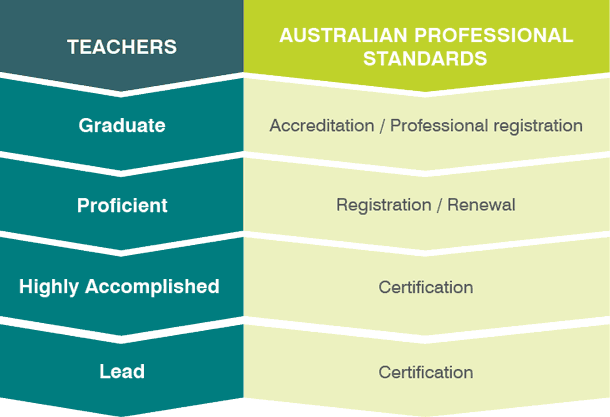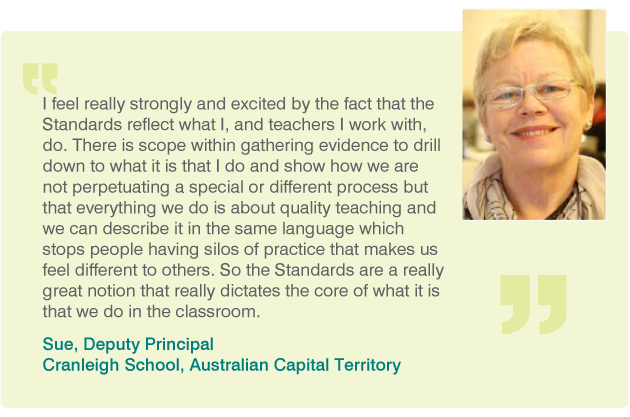Reflection
Explore these questions by yourself, as part of a team, or with a critical friend/mentor.
From your existing knowledge, how do you think the Standards help define effective teaching?
How do the Standards currently make a difference to you as a teacher and/or leader?
How are the Standards currently being used in your education setting?
How can teachers effectively collaborate with colleagues to share their understanding and application of the Standards to support professional development/growth?

The Standards are a public statement of what constitutes teacher quality. They define the work of teachers and make clear the elements of high-quality and effective teaching that will improve educational outcomes for students.
The Standards are organised into four different career stages: Graduate, Proficient, Highly Accomplished and Lead. The Standards explain what you should be aiming to achieve at every stage of your career so you can improve your practice inside and outside
of the classroom.
You can read through the Standards on the AITSL website, navigating between different career stages and different focus areas.
The Standards provide education settings with a common language of what effective teaching looks like, understanding that there will be differences in individual contexts and priorities. The Standards are used by education settings, education systems
and sectors in a variety of ways to provide direction and structure in the preparation, support and development of high-quality teachers.
Teachers need to evidence certain requirements of the Standards throughout their careers, whether it’s to become a registered teacher or to achieve Highly Accomplished and Lead certification.
The Standards enhance the professionalism of teachers by raising the status and contributing positively to the public standing of the profession.
The Standards serve several important purposes:
- supporting improvement in the quality of teaching and learning
- increasing community confidence in the profession
- providing a shared language for the profession
- defining the professional responsibility of teacher to meet the learning needs and aspirations of all learners, including Aboriginal and Torres Strait Islanders, those with culturally and linguistically diverse backgrounds, and those with additional
needs
- supporting the professional growth and career development of teachers throughout their careers.
The Standards do this by articulating the skills needed by teachers, and by providing a developmental framework that teachers can use to support their own professional growth.
The Standards provide a continuum of capabilities and expectations, and a nationally consistent basis for valid, fair and reliable identification and recognition of the teachers who demonstrate competence in quality professional knowledge, practice and
engagement.
You can use the Standards to identify your current and developing capabilities, professional aspirations and achievements. The Standards help you critically reflect on your own practice and the impact you have on students in your classroom, and on your
colleagues’ practice. They can support you to proactively seek to understand and meet the needs and aspirations of all students, including those whose cultural backgrounds differ from your own.
The Standards can assist you to:
- self-reflect on the impact of your learning and practice on student outcomes
- self-assess your current practice
- conduct professional discussions with colleagues
- develop performance and development goals
- formulate professional learning plans.
Departments of Education, Catholic education offices and Independent schools associations in each of the states and territories are also a useful source of information and resources regarding the Standards.
Reflection
Now you have read more about the Standards, look back at your responses to the first reflection activity.
Have your answers changed?
The Standards were developed through research, expert knowledge, a review of existing standards, collaboration with employers and professional associations across Australia, and significant consultation. The process built upon the work of previous national
frameworks and agreements.
Stakeholder consultations were held, with 120 single and consolidated submissions received from the Federal, State and Territory governments and regulatory authorities, education unions, professional peak bodies and individual schools and teachers.
The Standards were then tested across systems and sectors, different education setting types, and a range of geographical locations. The validation process involved two surveys as well as focus group sessions held in every state and territory with nearly
6,000 teachers and principals from hundreds of schools around Australia participating.
Activity
What is the value of having national Standards? Compare your thoughts with the ideas in the quote from Sue below.

Watch the below animation, take notes and then complete the reflection questions.
https://www.youtube.com/watch?v=EjMBxxNaboE
Video notes
Reflection
The Standards provide a common language around quality teaching in Australia. What are the benefits of this?
How could you strengthen your use of the Standards to reflect on and enhance your practice?
How do the Standards describe a teacher’s responsibility to ensure the classroom environment is suitable for all students?
Deepen your understanding with
Alternatively, return to the